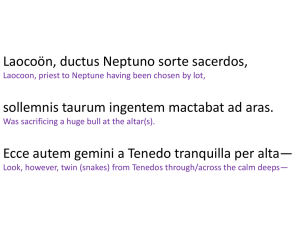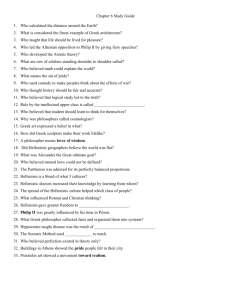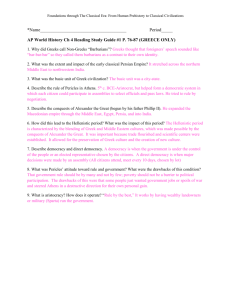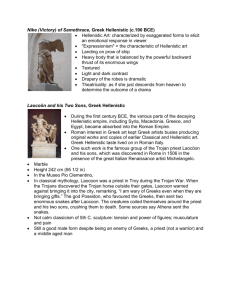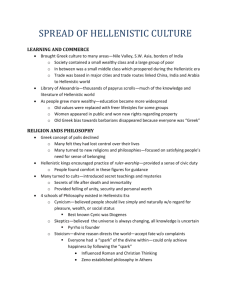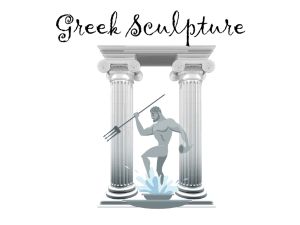The Transition from the Classical period to the
advertisement
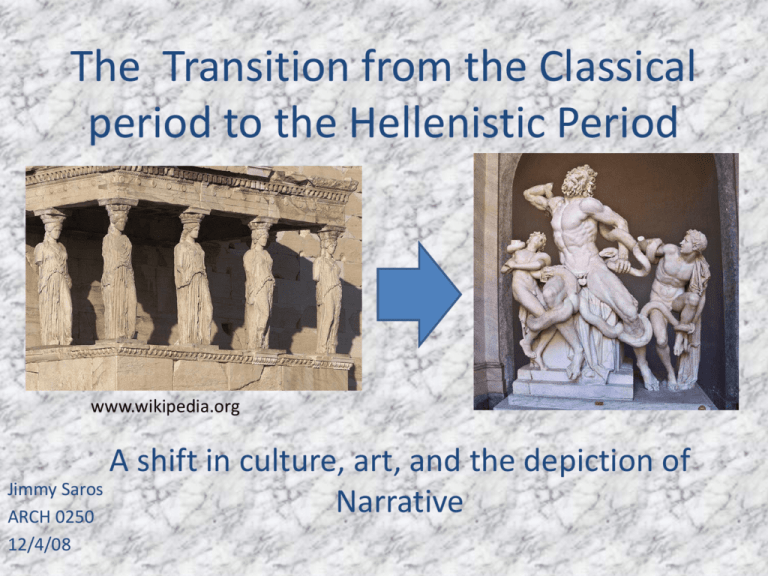
The Transition from the Classical period to the Hellenistic Period www.wikipedia.org A shift in culture, art, and the depiction of Jimmy Saros Narrative ARCH 0250 12/4/08 Classical Greece • Split up into City States • Said to be the foundation for western civilization. www.usu.edu Characteristics of Classical Period Art • Artwork of people as ideals of beauty or physical perfection. • Explored various naturalistic poses of human form. • Figures commonly stood in the “contrapposto.” a defining element of Greek sculptural technique. Canon of the Doryphoros (Spear Bearer) www.answers.com Narratives of the Classical Period Greek Warriorwww.Britannica.com Victorious Athlete- www.wikipedia.com The Porch of Maidens • Can be found in the Erechtheum Erechtheum, south view- www.wikipedia.com The Porch of the Maidens • Also known as The Porch of the Caryatids. • Story comes from the Persian Wars. • Not all of the Greek city-states fought against the Persians. • Some city-states remained neutral, and in some cases the city states became allies of the Persians after seeing their massive army approach. • The Porch of Maidens represents as a reminder to the public of the invasion on the town of Caryae which was in northern Laconia. • Once the enemy was defeated and driven out of the city, all of Greece turned against the town of Caryae. • All of the men in Caryae were killed. • All of the married women were held as prisoners. The Maidens •Women had to wear stoles and ornaments to show they were married. •Captive maidens were led through the city to be made an example of. •The roof that rests on top of the maidens heads represents the punishment for their sins of betraying their country. www. images.encarta.msn.com The New Era • The cause of the shift to the Hellenistic period began when Alexander the Great became emperor. • He split his empire into a number of smaller dynastic empires instead of small city states. • His conquest of spreading the empire caused Greek culture to spread as far as India. • The Hellenistic period was a result of the fusion between the ancient Greek world and Asia. The major Hellenistic realms the Ptolemaic kingdom the Seleucid empire Macedon Epirus Changes in Art • Greek art became much more diverse and showed influence from the cultures that were now acquired into the Greek empire. • Everyday people and scenes were now being depicted through artwork. • Art was much more elaborate and full of expression; expression that mostly focused on suffering and pain. • Artists became much more skilled. • During this time sculptures became more and more naturalistic. • Displayed and Evoked emotion. Hellenistic Sculptures Wounded Gaul- www.britannica.com Gaul Killing Himself and His Wifewww.wikipedia.com Depictions of Narratives • Now artwork showed scenes from the stories and events they are based off. • Most of these Narratives focused on pain and suffering. • Depicted tragic events. • The viewer has an idea of what is happening without having any knowledge of the narrative itself. The Laocoon Group www.wikipedia.com www.wikipedia.com Antiphantes Thymbraeus About The Laocoon Group • A marble sculpture. • Central figure is the Trojan priest of Apollo, Laocoon • Laocoon is shown with his two sons. • They are being strangled by a serpent. Narrative • The scene that is being depicted of Laocoon comes from Aeneid. • The Aeneid is a Latin epic poem written by Virgil. • Based off of episodes from the Trojan War which took place between Troy and Sparta. • A scene from the Aeneid is being illustrated in The Laocoon Group. • In the Aeneid, Sparta offered Troy the gift of a wooden horse. • The Trojans were going to except the gift, but then Laocoon went with his two sons to warn the Trojans about accepting the wooden horse. • Troy disregarded his advice and accepted the horse. • Then Greek goddess Athena, who supported the Greeks in the war, sent a sea serpent to strangle Laocoon and his two sons. • Despite they’re hard fought struggle with the serpent, Laocoon and his two sons were killed. Differences The effect on Narrative • This transition between the classical and Hellenistic period caused the narratives told through the artwork to express scenes that depicted action and that dealt with pain and suffering. • The classical period of course had events that dealt with this, but the difference is that it was not directly expressed in the artwork.
